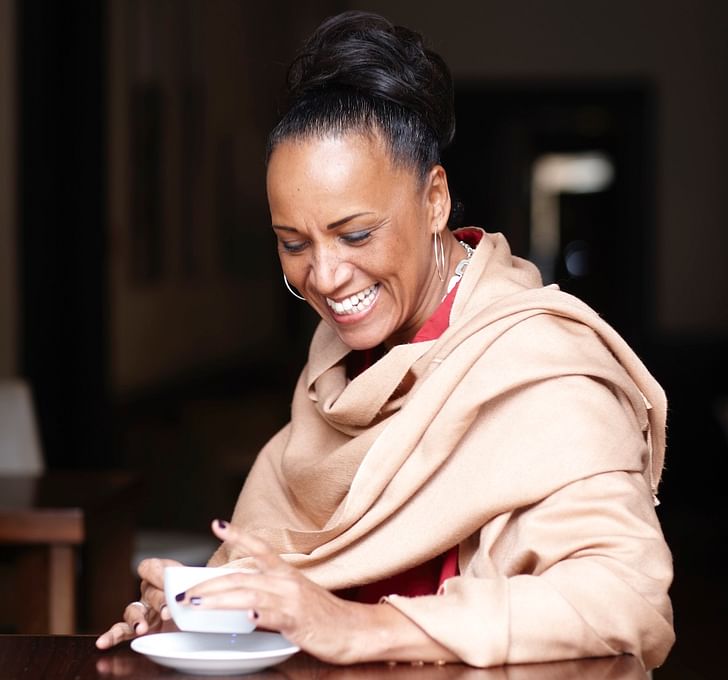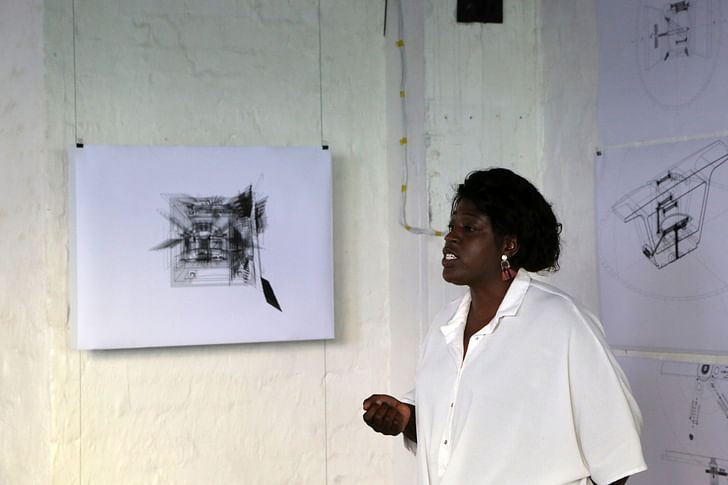

Deans List is an interview series with the leaders of architecture schools, worldwide. The series profiles the school’s programs, pedagogical approaches, and academic goals, as defined by the dean–giving an invaluable perspective into the institution’s unique curriculum, faculty, and academic environment.
For this installment, Archinect spoke with Lesley Lokko, a multi-talented architect, best-selling novelist, architectural educator, and now, Dean of the The Bernard and Anne Spitzer School of Architecture at the City College of New York (CCNY), New York City's premier public architecture school. The 420-student school offers a keen focus on "the urban environment as the most important generator of ideas" and offers professional undergraduate degrees in architecture and graduate degrees in architecture, urban landscape architecture, urban design, and sustainability in the urban environment.
We caught up with Lokko as she prepares to move to America from South Africa—where she has been based for five years as the Director of the Graduate School of Architecture at the University of Johannesburg—to discuss, among other topics, her long road to architecture, expanding the definition of an "architect," and decolonizing design education.
Can you briefly describe CCNY’s pedagogical stance on architecture education?
Just. Sustainable. Imaginative. As the only public school of architecture in New York City, our programs are shaped by the incredible diversity of our staff and students and a deeply-held and shared belief in the power of education to transform lives, communities, and societies. Our location in one of the world’s most interesting, complex and challenging cities encourages us to view New York as a genuine laboratory of the future, constantly testing our responses and propositions.
Decolonization isn’t a zero sum game. It’s not about replacing one canon with another. I’ve always understood it—and I will continue to understand it—as a way to expand knowledge, critically, rigorously, inventively.
What insights from your past professional experience are you hoping to integrate or adopt as the dean?
I think it’s fair to say I’ve led a fairly checkered professional life – from working in practice to writing bestselling novels to academia and now leadership, which I see as its own job, not an add-on.
Each of these has required different (and sometimes diametrically opposed) skills: writing fiction, which I did full-time for nearly twelve years, involves a fairly delicate dance of engagement and withdrawal from the world in order to process insights and experiences and turn them into someone else’s narrative; working in practice requires enormous amounts of patience and attention to detail; and leadership requires a thick skin, decisiveness, and a graspable vision. I’d say I’ll be taking a little bit of each into this new phase of my professional life as dean. In my previous role as Director of the Graduate School of Architecture at the University of Johannesburg, I learned very quickly that consensus has to be built, literally, step by painstaking step. There are no shortcuts.
Living and working in South Africa, one of the world’s most unequal societies, over the past decade has given me renewed and profound respect for the power of students to engage, shape, and question their inherited future.
What kind of students do you think would flourish at CCNY and why?
Students who are interested in the world and its myriad, mysterious ways; students who take nothing for granted, including their own education; students who are interested in the design of a future practice, which means being open, curious, committed and imaginative.

Living and working in South Africa, one of the world’s most unequal societies, over the past decade has given me renewed and profound respect for the power of students to engage, shape, and question their inherited future. If those students—some of whom come from the poorest and most under-represented sections of society—could do it, I cannot wait to see what students at CCNY will do in the coming years.
What are the biggest challenges, academically and professionally, facing students today?
It’s usual to answer that question by talking about cost, which is clearly high on everyone’s agenda, especially students. However, I prefer to think about cost in slightly broader terms of “value.” What is this education worth?
For some, it’s professional in the classical sense of the word—attaining the social and financial status of the professional. For others, it’s looser, more elliptical. In thirty years (give or take) of teaching, I’ve seen thousands of very different students enter the academy and exit, often changed and transformed by the experience in ways neither they—nor we—could predict. The biggest challenge I have faced, particularly lately, has been to persuade students that those changes will happen. That the experience of architectural education will change the way they think, see, and act, and that the change is worth it. Our teaching methods haven’t changed much over the past fifty, sixty years . . . and yet the world has. That’s the biggest challenge right there.
If the city is the “natural” home of the built environment professions, being in one of the world’s quintessential urban conglomerations means the potentials for expanding and exploring what we mean by the words “architect,” “landscape architect,” “urbanist,” and “designer” are myriad.
What are some of the advantages of the school’s context—being at CCNY and in the New York metropolitan region—and how do you think they help make the program unique?
Well, seeing as I’m writing this at my desk in Johannesburg—I leave in a week’s time—much of what I’m about to say is speculation. I’ve taught at schools in more rural settings (Iowa State; Umeå, Sweden; Limerick, Ireland) and in large cities (London, Chicago, Johannesburg) and the one thing I found that was common to all those places—with the exception of London—was the fear students had of “the city.” For all sorts of reasons, the city was seen as a place of unpredictability and uncertainty . . . a place of strangers where anything could happen. New York, like London, has its underbelly but New Yorkers (insofar as I’m able to judge from 6,000 miles away) are not afraid of New York. There’s a brash and beautiful confidence in the students I’ve encountered thus far, which I find inspiring, energizing. If the city is the “natural” home of the built environment professions, being in one of the world’s quintessential urban conglomerations means the potentials for expanding and exploring what we mean by the words “architect,” “landscape architect,” “urbanist,” and “designer” are myriad.
How would you like the school to have changed during your tenure?
I’ve heard it said many times since my appointment was announced that “[CCNY] is the poor man’s Harvard.” I hope that by the time I leave, those two words, “poor” and “Harvard” will no longer be in use. City will be its own, unique school, defined not by the cost of its education but by the wealth of its imagination and inventiveness.
In your previous role at the University of Johannesburg, you helped to start the school’s graduate program and eventually grew the department from 11 students to over 100. How did this experience shape your perspective as an educator?
I’m going to answer that by saying something quite British: “gosh!” Everything I know about running a school stems from this most recent experience. On the one hand, it was incredibly challenging: starting up a school from scratch—there was a Master’s program in place but not the GSA—was by far the most difficult thing I have ever done. Administrative competencies in South Africa are generally very low: the sheer effort it requires to get anything done is overwhelming. But, on the other hand, it was one of the most rewarding periods of my life. To see students come into the program with little or no self-confidence in terms of how they understood architecture and their role within the discipline—and this was especially true of black students and students from lower income groups—and emerge two years later bursting with energy, ideas, self-esteem . . . that has been priceless, beyond compare. Driving the school’s vision and agenda practically single-handedly was exceptionally difficult and the experience taught me that without a committed and passionate team standing alongside, it’s impossible to accomplish that vision. Team players are key. At all levels.
I’ve heard it said many times since my appointment was announced that “[CCNY] is the poor man’s Harvard.” I hope that by the time I leave, those two words, “poor” and “Harvard” will no longer be in use. City will be its own, unique school, defined not by the cost of its education but by the wealth of its imagination and inventiveness.
You earned a PhD from the University of London in 2007; Can you share a bit about why you decided to go for this higher level of education? How did the experience shape your conception of what it means to be an architectural educator?
Architecture was actually my third degree: I began my academic life studying Hebrew and Arabic, then switched to sociology and finally landed upon architecture. From the minute I entered the Bartlett (UCL London), I knew I’d made the right choice. However, I was a spectacularly bad undergraduate student . . . I came to architecture at the age of 28 and found that many of the skills I’d previously learned simply didn’t work. It wasn’t enough to be punctual or have neat handwriting, something more was required. That “more” didn’t really find its voice until I was in the Master’s program when I began—at last—to recognize that the issues that drove me personally (issues of race, identity, gender, society, culture) would be the same drivers in my professional career. It also seemed to me that I’d only begun to touch on those issues in the Master’s program and so doing a PhD seemed the natural—and only—route to take.

What is the current state of scholarly architectural writing, in your opinion, and how do you hope to impact this realm form your new position?
By and large, architects don’t write well. We don’t speak well, either, which is a conundrum I’m still grappling with. Our internal language—they way we speak to, and about, architecture—tends to be convoluted, obscure, incoherent, and baffling. Yet our work—whether in buildings, drawings, films—is visceral, direct, experiential, explorative. Writing is its own form—there are good writers and poor writers and then there are people who think they can write, but can’t. Having made a living from writing for quite some time, I’m especially mindful of what it means to be clear, to be precise, to be descriptive without being didactic . . . to write simply and expressively and allow the medium (writing) to carry its own message. If I hear one more student say, “my building situates itself” . . . No, sweetheart, your building is. It just is. It doesn’t get up and walk around and decide where it’s going to go.
You are a best-selling novelist who has written eleven books; Can you share some thoughts on the relationships between narrative and architecture, especially as it relates to the increasing prevalence of experience- and narrative-driven design methodologies in design schools today.
Here I have to confess to a particularly soft spot for narrative-as-a-form-of-exploration. Yes, there are always risks associated with the self-as-starting-point. However, the idea that the “scholarly” isn’t about the self (albeit a long-dead, generally white, male self) is a fiction. One of the most exciting things about being in South Africa over the past five years has been to witness the slow maturing of the “self” (expressed through experience and personal narrative) into something more abstract, more universal, and therefore, more available for interpretation and appropriation by others, many of whom do not share the same cultural or social provenance. That’s been unbelievably exciting: to witness canon slowly, painfully changing . . . as a West African female architect-educator, it doesn’t get much better.
I came to architecture at the age of 28 and found that many of the skills I’d previously learned simply didn’t work. It wasn’t enough to be punctual or have neat handwriting, something more was required. That “more” didn’t really find its voice until I was in the Master’s program when I began—at last—to recognize that the issues that drove me personally (issues of race, identity, gender, society, culture) would be the same drivers in my professional career.

In recent years, there has been increased conversation within architectural circles regarding the topic of “decolonization,” particularly in light of the The Settler Colonial City Project and American Indian Center’s installation at the Chicago Architecture Biennial. From your perspective, what does it mean to decolonize architecture, and specifically, to decolonize architecture education?
I suppose the clearest way to answer your question is to say that none of us yet know what a decolonized or transformed curriculum actually looks like, but we’re all, in varying degrees and to varying extents, engaged in trying to find out. In some places, like Australia, South Africa, the UK, the question is more urgent than in others. I’ve yet to find out where the US sits on this particular spectrum. I gave a talk at the Australian Institute of Architects annual conference a few months ago, where the topic of decolonization and transformation (of the profession) was very much on the agenda and everyone’s lips. The invited speakers were all interesting but the audience was predominantly white and male and in the reception afterwards, after I’d been asked for the third time if there was any more Chardonnay, I wondered how much of the talk was simply just that: talk.
none of us yet know what a decolonized or transformed curriculum actually looks like, but we’re all, in varying degrees and to varying extents, engaged in trying to find out.
However, a few days later, an Australian architect, Mark Raynard, posted a message on Instagram, which I continue to go back to. I’ll quote a very small section here:
Blokes, it’s all gonna be OK. Hand over the microphone. Sit back, relax and listen. The last part is the best part. Listen, because if you truly listen, then you quickly realise that you are not under attack but rather get to see a more beautiful, diverse, inclusive, and interesting future. It costs us nothing and it's going to be great. As always, we (white men) will only benefit from this much-needed, more equitable future.
Decolonization isn’t a zero sum game. It’s not about replacing one canon with another. I’ve always understood it—and I will continue to understand it—as a way to expand knowledge, critically, rigorously, inventively. Not to cut-and-paste or mimic but to add, to explore, and augment what we already know. Part of that process will of course involve critique and, in some cases, overturning previously held beliefs, but that’s what makes it such a rich and risky business. The “job” of the university is to produce new knowledge, or at least that’s how I’ve always understood it. Not simply to reproduce what we already know. Decolonization is a gift. We all benefit.
Antonio is a Los Angeles-based writer, designer, and preservationist. He completed the M.Arch I and Master of Preservation Studies programs at Tulane University in 2014, and earned a Bachelor of Arts in Architecture from Washington University in St. Louis in 2010. Antonio has written extensively ...
1 Comment
on decolonization...see Sylvia Wynter on some Derrida speech...
hint: deconstruction, not cannons.
Block this user
Are you sure you want to block this user and hide all related comments throughout the site?
Archinect
This is your first comment on Archinect. Your comment will be visible once approved.